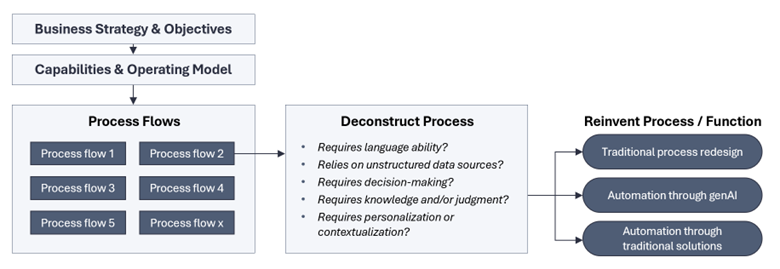Automating Inefficiency or Redesigning for the Future?
Rewiring Capital Markets: Process Redesign + GenAI
Too often, firms mistake tools for transformation. That confusion explains why so many leaders are asking: where’s the value in our GenAI investments?
The answer is clear — value doesn’t come from layering AI on top of legacy workflows. It comes from rethinking those workflows entirely. Business process redesign is the lever for GenAI success. Done well, it creates compounding efficiencies and entirely new capabilities that lift performance to a different level.
Research confirms this, stating that fundamental workflow redesign is the single strongest factor tied to bottom-line AI impact. Yet only 20% of organizations deploying GenAI have redesigned even parts of their workflows [1]. The message is blunt: real value comes from transformation, not tooling.
The key question isn’t “How can AI speed up this task?” but “Why is this task done this way at all — and how could AI let us reinvent this entirely?”
From Layering to Rethinking Business Process Redesign
Many financial institutions are discovering the hard way that pilots and point solutions won’t move the needle. While a few leaders are pushing forward, many firms are just tinkering at the edges of GenAI, unwilling to rewire legacy processes.
Organizations need to pick functions where AI can truly transform the way work gets done, then rebuild the process from the ground up. That often means reshaping roles, decision rights, and handoffs so humans and machines each do what they do best. It means challenging decades-old operating models. And it means investing in change management so teams trust and embrace new ways of working.
Leaders who take this leap — treating AI as a strategic, top-down transformation rather than a tech experiment — are already pulling away from those stuck in “tool mode.”
What GenAI + Process Redesign Looks Like
Here are a few examples to bring this to life:
Client Onboarding: Agentic architectures replace fragmented, form-heavy workflows. Supervisory AI agents orchestrate KYC, AML, and CRM sub-agents, escalating only when human judgment is needed. Cycle times shrink by 30–50%, onboarding becomes client-friendly, and relationship managers reclaim time to focus on trust and growth.
Front Office Research: AI research agents now scan filings, transcripts, and signals around the clock, drafting theses and surfacing anomalies. Analysts shift from data gathering to interpretation and hypothesis testing. The payoff: 30–40% productivity gains, broader coverage, and faster reaction times in competitive markets.
Client Reporting & Info Delivery: Quarterly PDFs no longer cut it. Reinvented reporting starts with client preference: interactive dashboards, natural language Q&A, even digital avatars. UBS has deployed digital avatars that deliver information directly, turning reporting into a real-time engagement tool. Firms that make this shift slash reporting costs drastically while deepening the advisory relationship.
Reconciliations & Processing: Instead of armies chasing breaks after the fact, GenAI enables proactive exception management. AI flags breaks, proposes fixes, and explains exceptions in plain language — storing each explanation in an institutional knowledge base. Over time, repeat issues vanish, manual effort declines, and firms build digital knowledge bases that preserve expertise even as employee turnover occurs.
The pattern is clear: when GenAI is paired with bold workflow redesign, firms achieve speed, scale, and capability leaps. When it isn’t, results remain incremental.
How Executives Can Lead Reinvention
For leaders in capital markets, the mandate is urgent: envision the AI-enabled future state — then mobilize your firm to get there. Four imperatives stand out:
Assess High-Value Workflows: Identify functions and processes that are strong candidates for AI automation and that have the potential to drive meaningful value. Apply filters such as language-intensive tasks and knowledge-based activities.
Start with a Clean Slate: Design “zero-based” workflows iterating on what is possible rather than bolting on tools. Use this as a north star and make incremental improvements to achieve this target state.
Anchor in Tech & Data Strategy: Ground AI transformation in enterprise data and infrastructure. Tying redesign to governance, cloud, and risk frameworks ensures scale and sustainability.
Empower People Through Change: Equip teams with new skills, evolve roles, and communicate the purpose behind the transformation. Demonstrate quick wins, reduce low-value work, and reinforce trust with strong governance.
High-level approach to selecting functions for reinvention
Reinvent or Fall Behind
GenAI holds transformative potential in capital markets. But the firms realizing this promise are those with the courage to reinvent, not just automate.
Early adopters are reporting meaningful productivity boosts and faster innovation cycles by weaving AI into their operations. More importantly, they’re building organizations that are adaptive to an AI-enabled future.
GenAI’s value is not in the model, but in the reinvention it unlocks. Those willing to reengineer their core workflows are creating tomorrow’s competitive edge today.
Want help jumpstarting that belief in your team? At BeaconAP, we blend AI strategy with cultural design—because we know real change takes both.
Let’s build something better, together.
1: McKinsey & Company – “The state of AI: How organizations are rewiring to capture value” (Global AI Survey, 2025)


